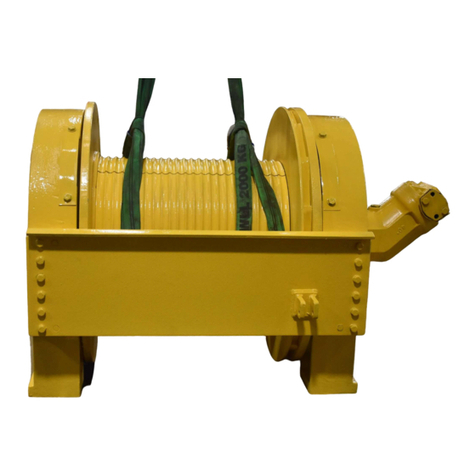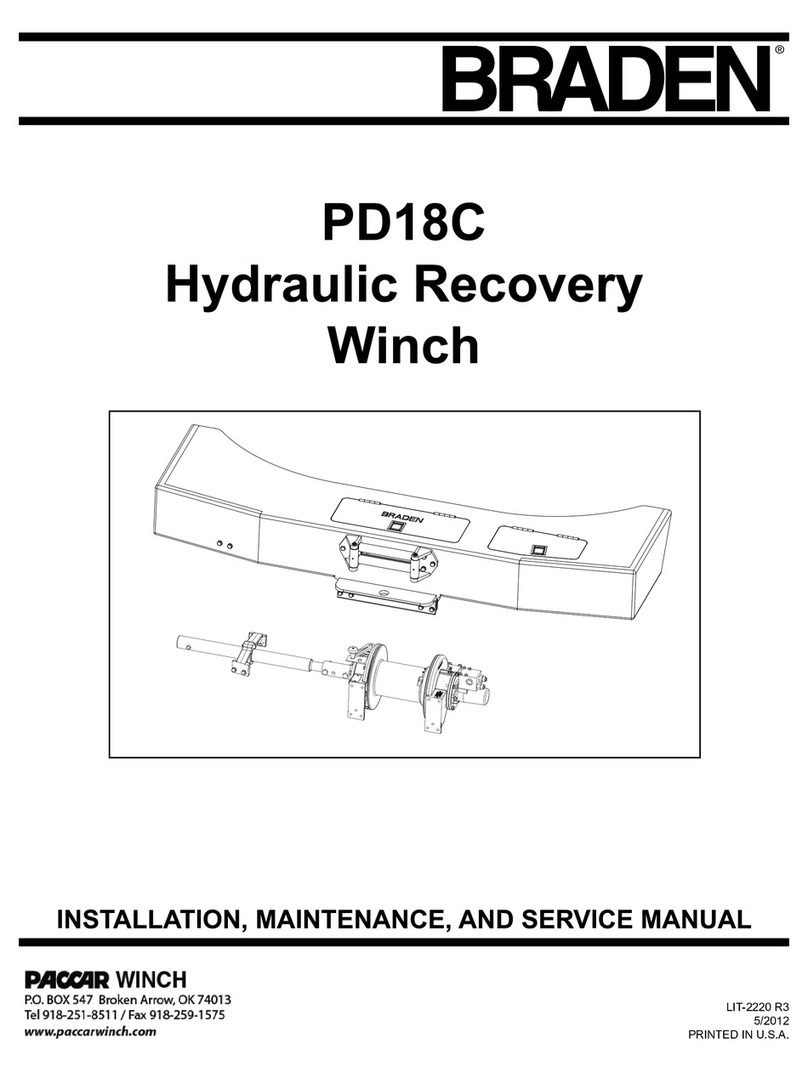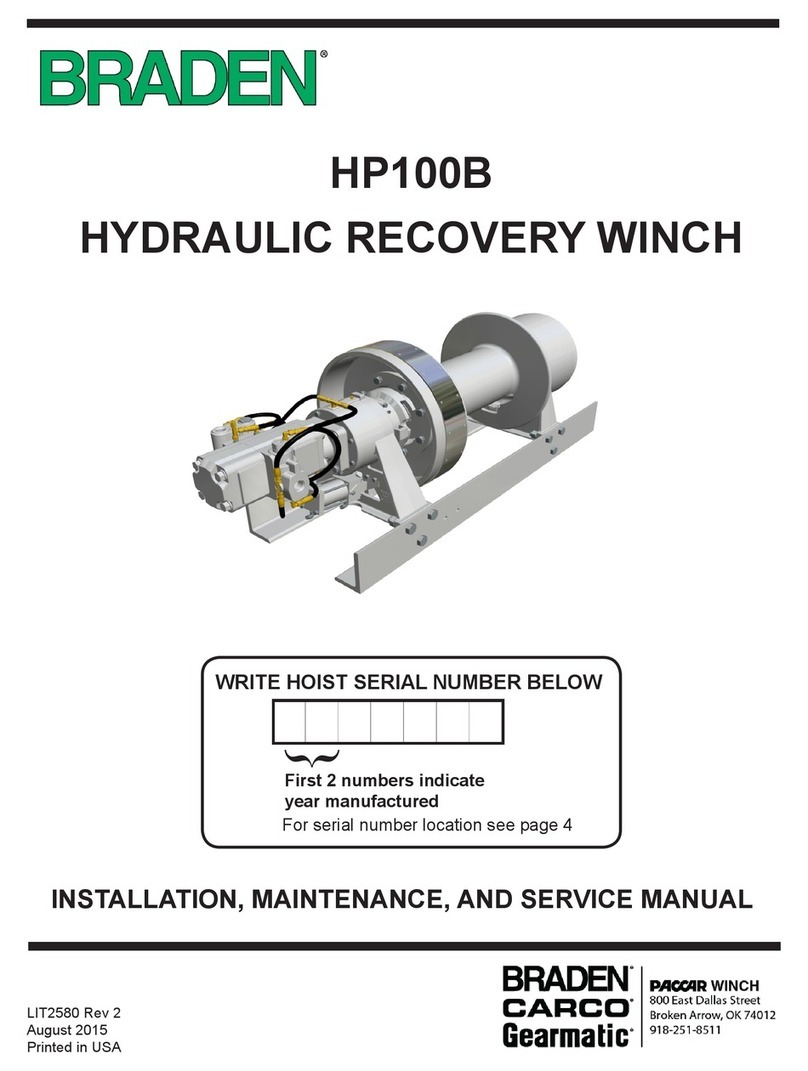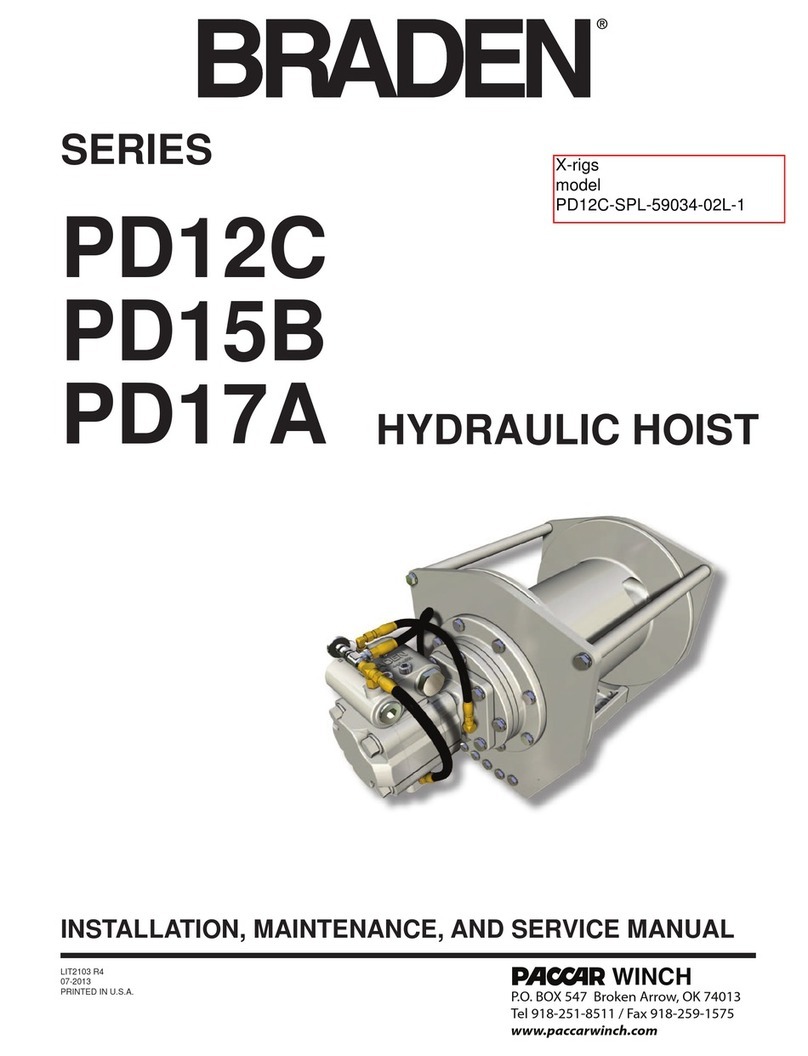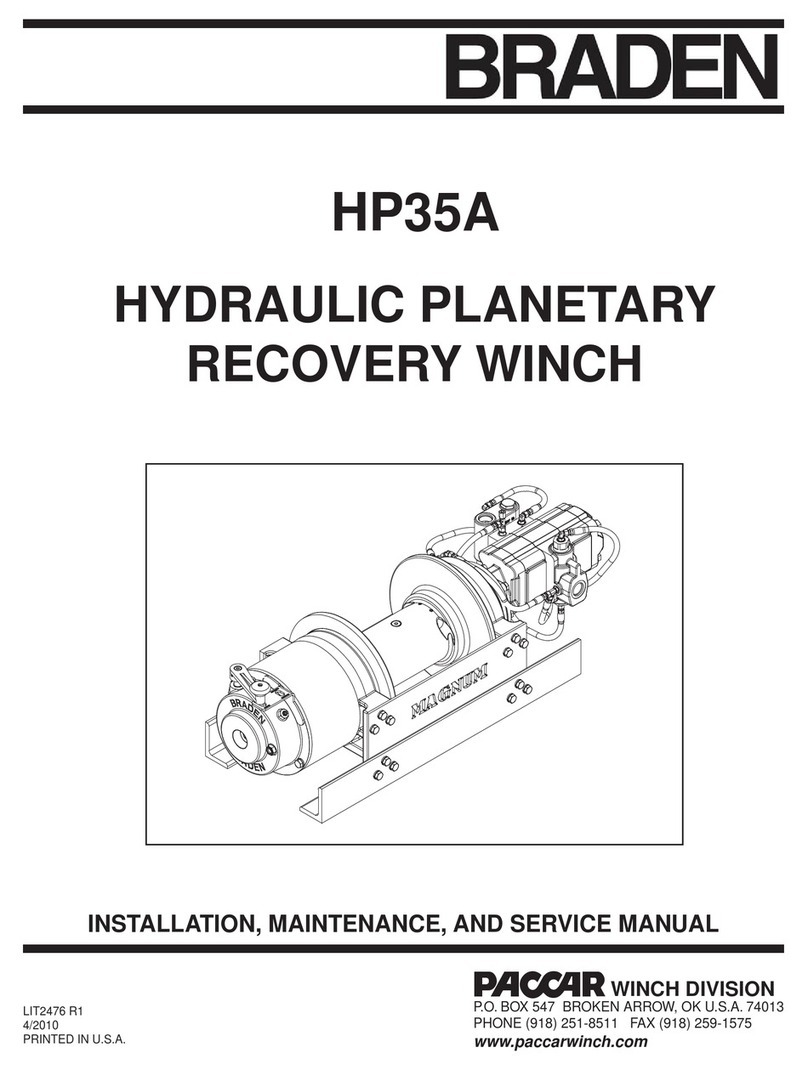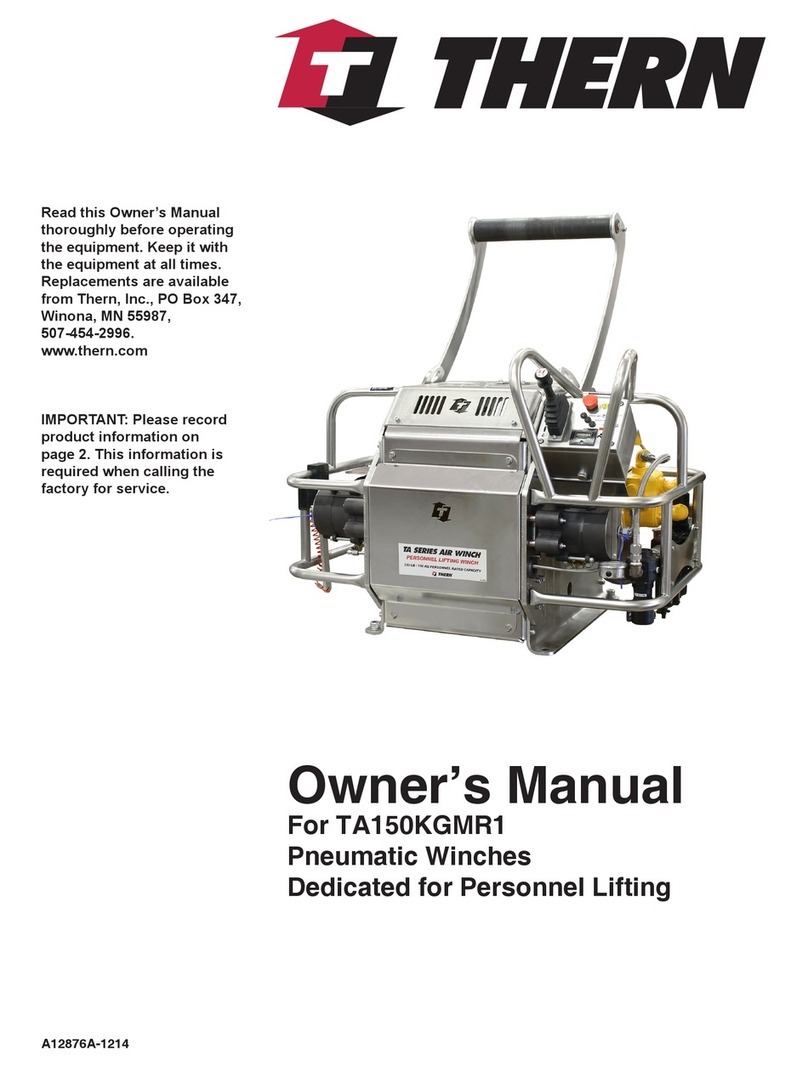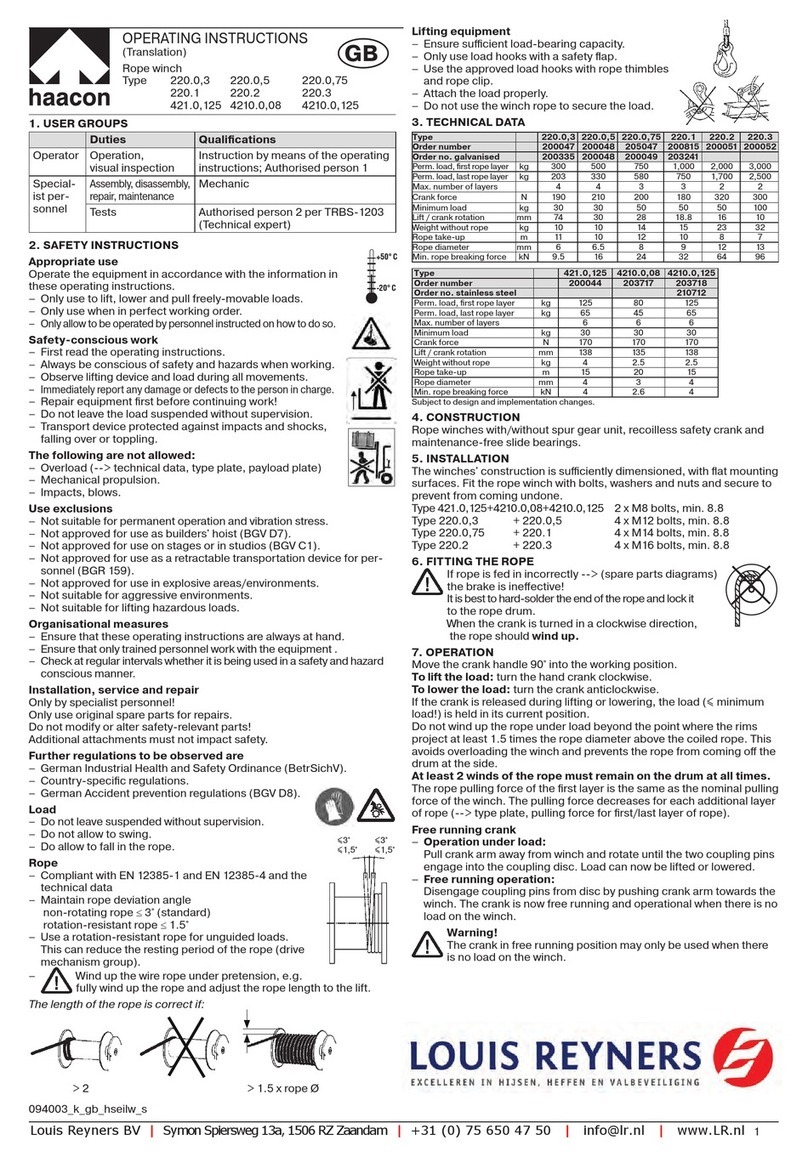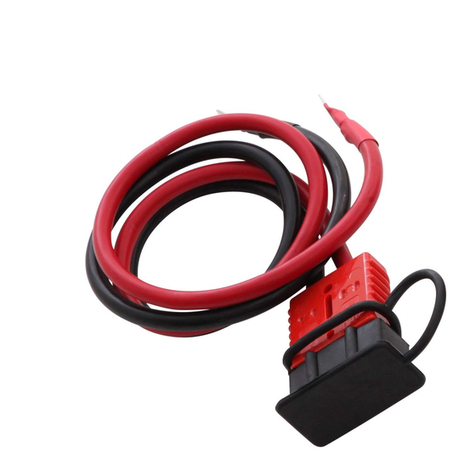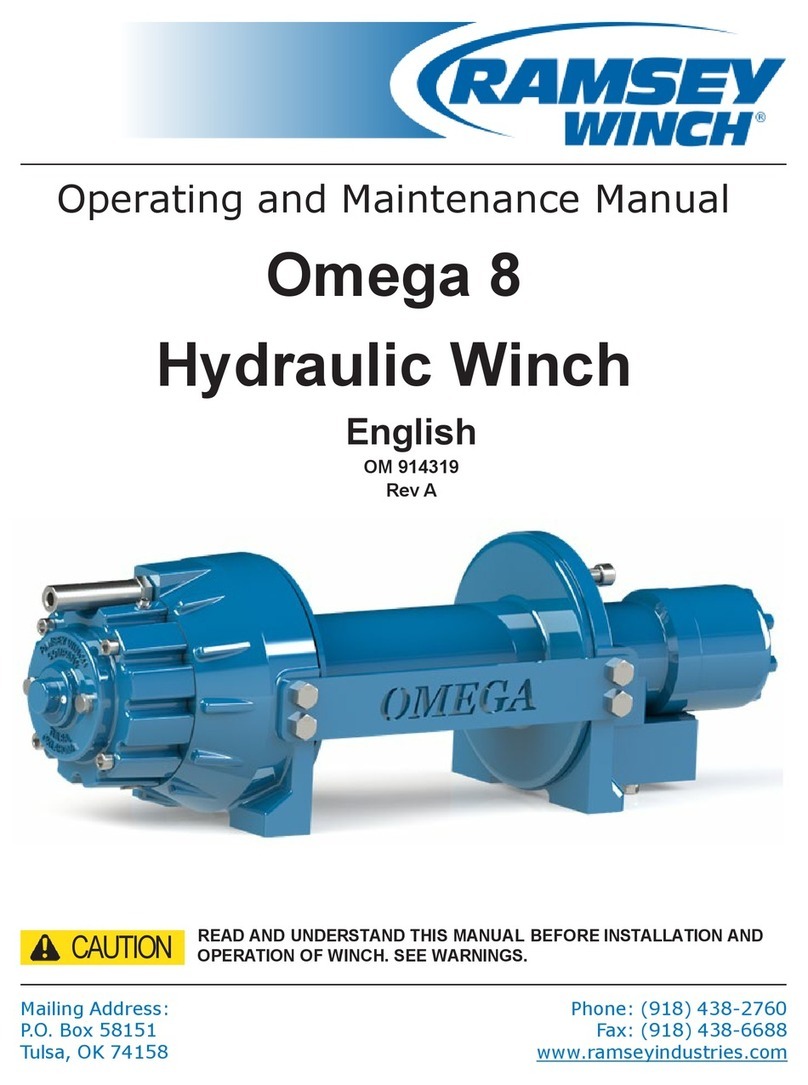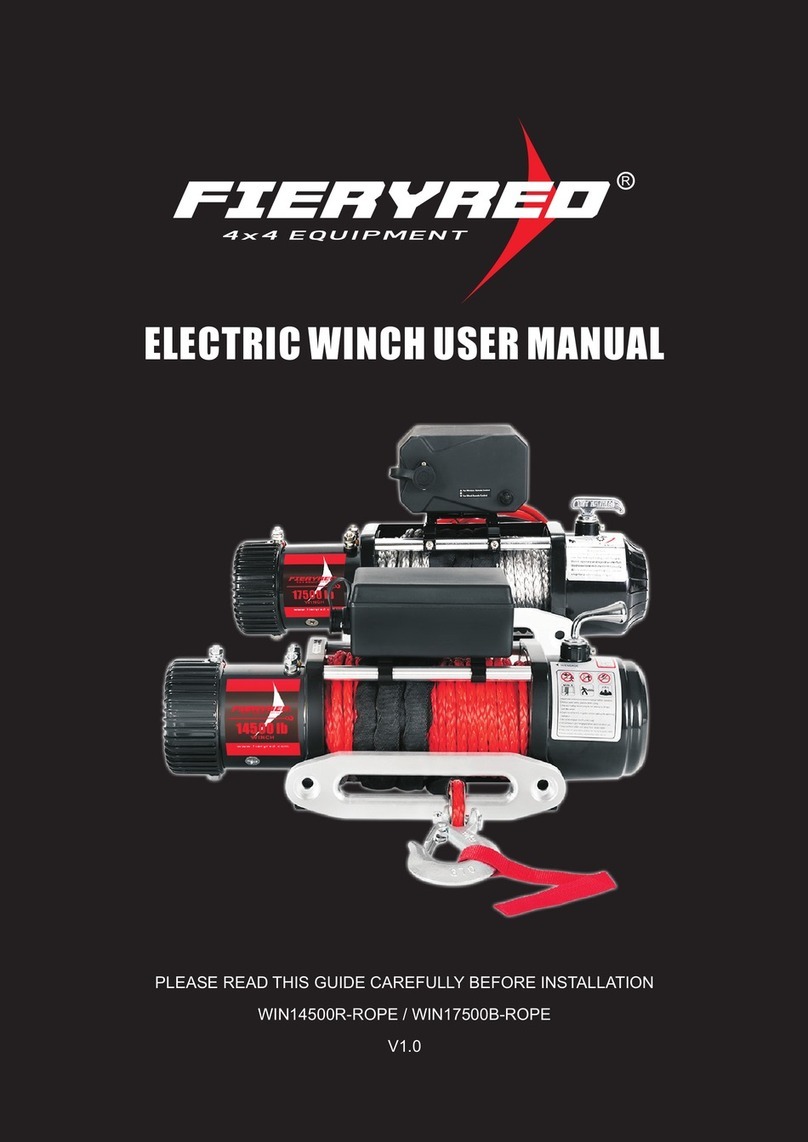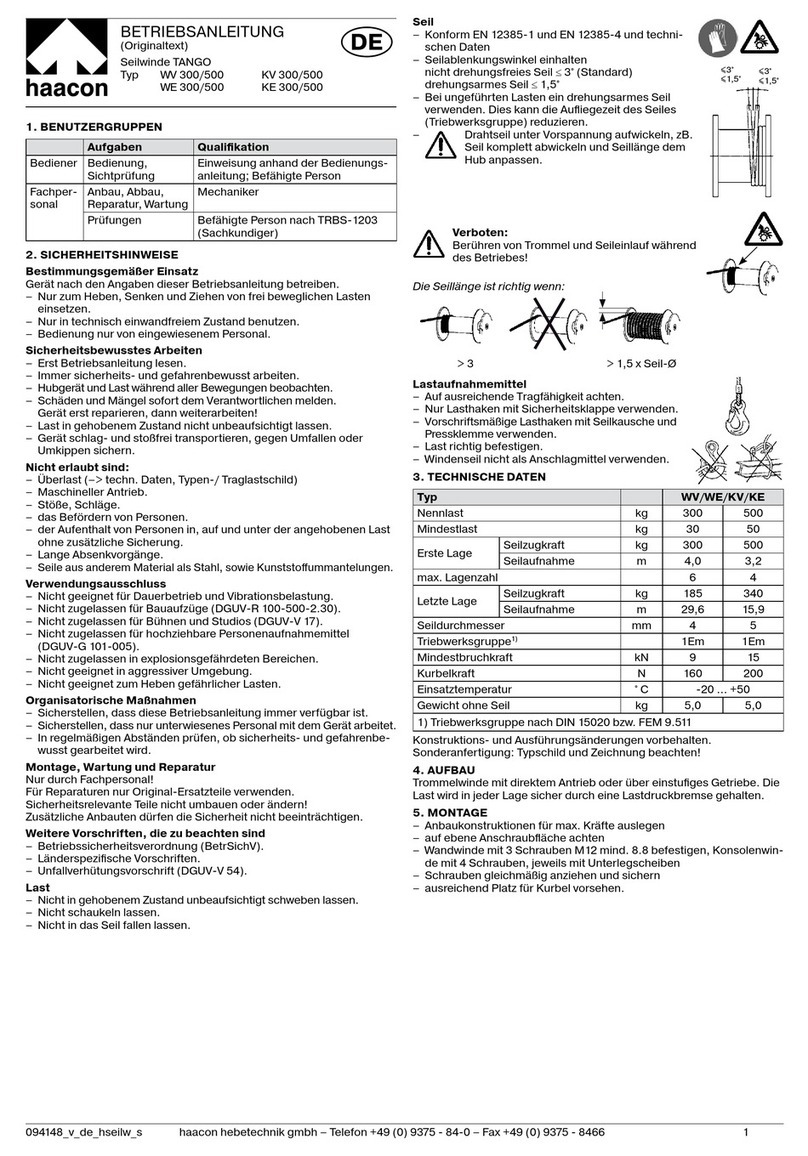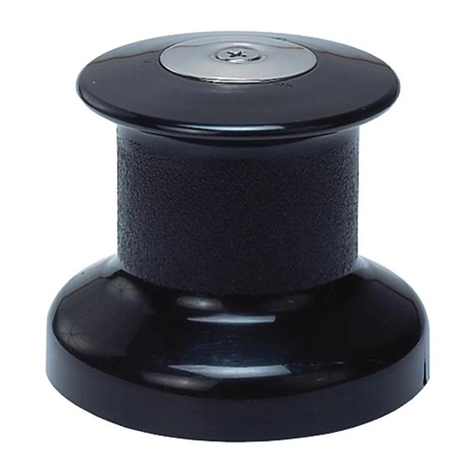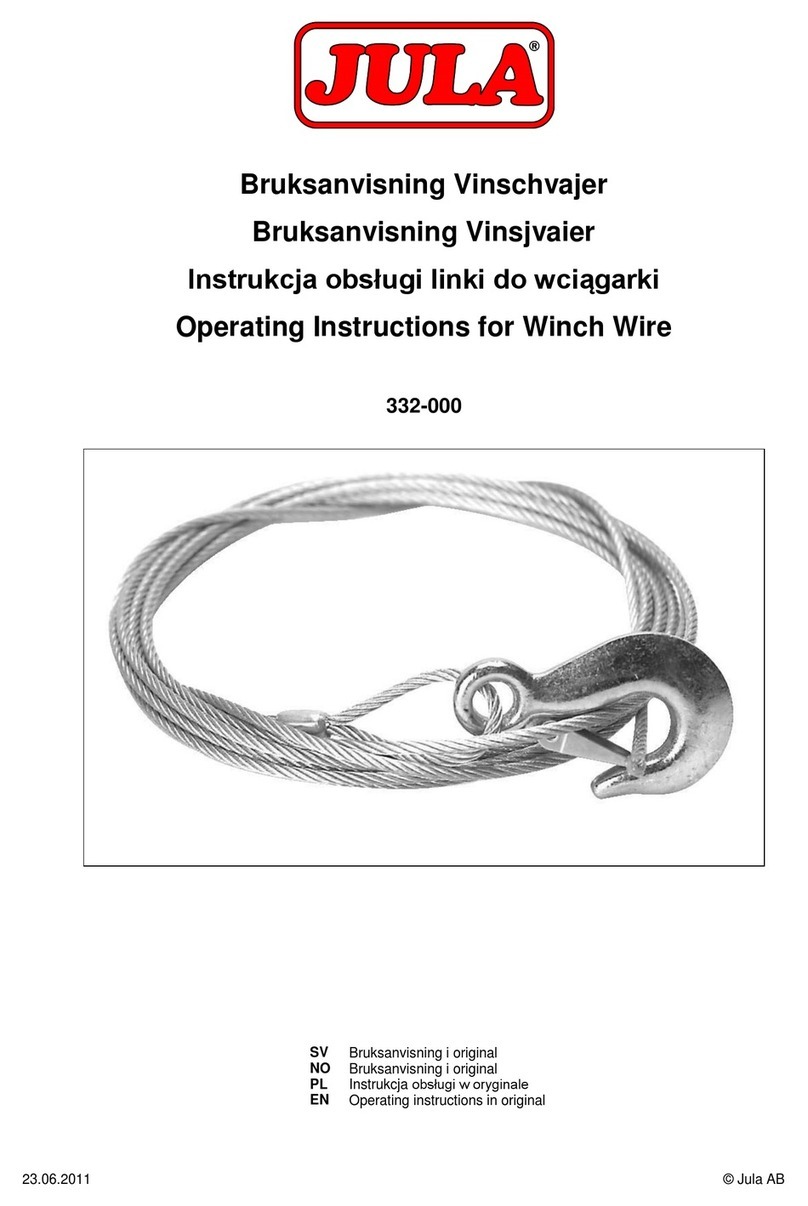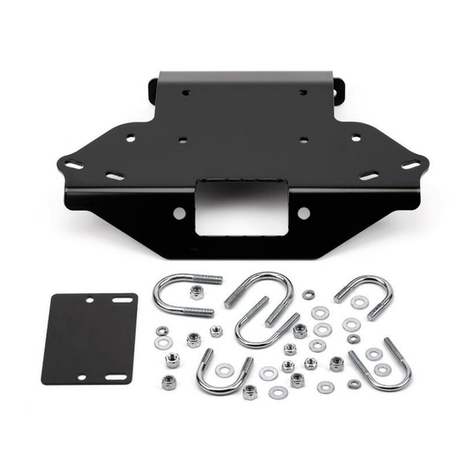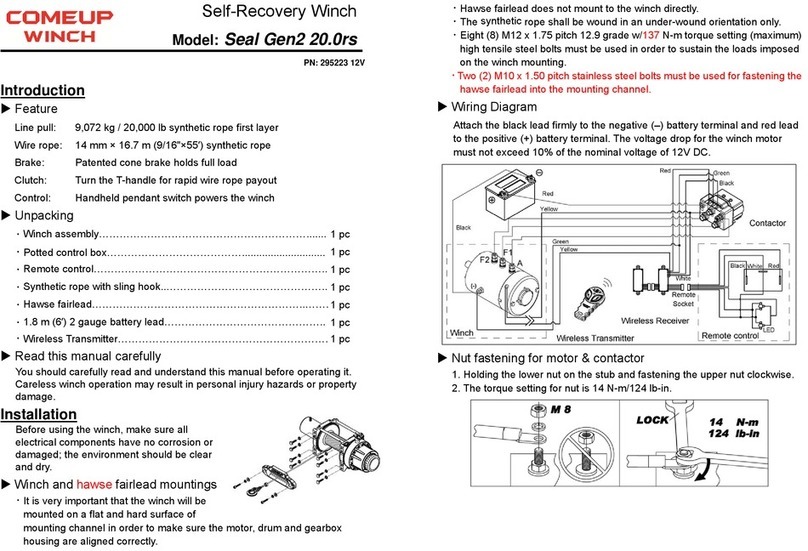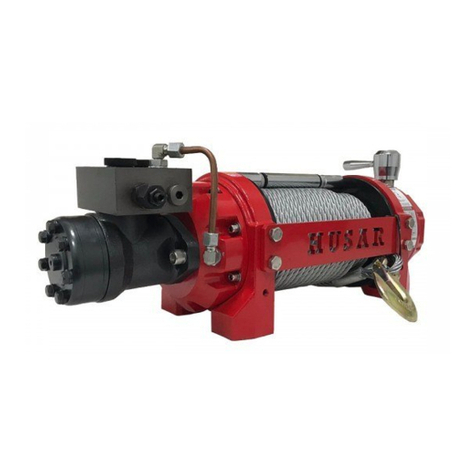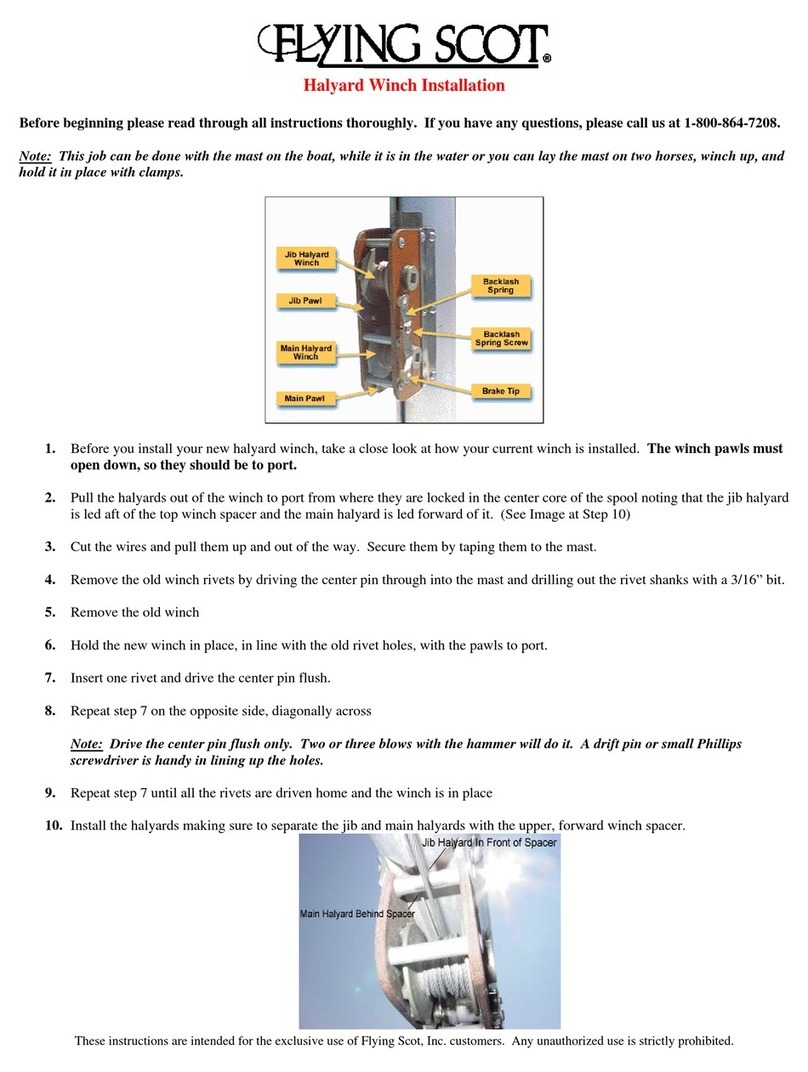BRADEN CH150A Series Manual

BRADEN
CH150A/CH230A w/Auxiliary Brake
PLANETARY HOIST
INSTALLATION, MAINTENANCE AND SERVICE MANUAL
LIT2222 R1
6/2005
Printed in U.S.A.
PACR WINCH DIVISION
P.O. BOX 547 BROKEN ARROW, OK U.S.A.7401
3
PHONE (918) 251-8511 FAX (918) 259-1575
www.paccarwinch.com
Copyright 2005 PACCAR Winch Division. All rights reserved.

TABLE OF CONTENTS
1
FOREWORD . . . . . . . . . . . . . . . . . . . . . . . . . . . . . . . . . . . . . . . . . . . . . . . . . . . .2
GENERAL SAFETY RECOMMENDATIONS . . . . . . . . . . . . . . . . . . . . . . . . . . .3
SPECIAL TOOLS . . . . . . . . . . . . . . . . . . . . . . . . . . . . . . . . . . . . . . . . . . . . . . . .4
BASIC OPERATION . . . . . . . . . . . . . . . . . . . . . . . . . . . . . . . . . . . . . . . . . . . . . .5
HOIST INSTALLATION . . . . . . . . . . . . . . . . . . . . . . . . . . . . . . . . . . . . . . . . . . . .8
WIRE ROPE INSTALLATION . . . . . . . . . . . . . . . . . . . . . . . . . . . . . . . . . . . . . . .8
HOIST OPERATION . . . . . . . . . . . . . . . . . . . . . . . . . . . . . . . . . . . . . . . . . . . . .10
HYDRAULIC CIRCUITS . . . . . . . . . . . . . . . . . . . . . . . . . . . . . . . . . . . . . . . . . .11
RECOMMENDED BOLT TORQUES . . . . . . . . . . . . . . . . . . . . . . . . . . . . . . . .11
PREVENTIVE MAINTENANCE . . . . . . . . . . . . . . . . . . . . . . . . . . . . . . . . . . . .11
TEAR DOWN INSPECTION . . . . . . . . . . . . . . . . . . . . . . . . . . . . . . . . . . . . . . .15
RECOMMENDED GEAR OIL . . . . . . . . . . . . . . . . . . . . . . . . . . . . . . . . . . . . . .16
INSPECTION RECORDS AND RETENTION . . . . . . . . . . . . . . . . . . . . . . . . .16
OIL SAMPLING AND ANALYSIS . . . . . . . . . . . . . . . . . . . . . . . . . . . . . . . . . . .17
BRAKE TEST PROCEDURE . . . . . . . . . . . . . . . . . . . . . . . . . . . . . . . . . . . . . .18
AUXILIARY BRAKE TEST PROCEDURE . . . . . . . . . . . . . . . . . . . . . . . . . . . .19
EMERGENCY LOWERING PROCEDURE . . . . . . . . . . . . . . . . . . . . . . . . . . .20
PERSONNEL HANDLING . . . . . . . . . . . . . . . . . . . . . . . . . . . . . . . . . . . . . . . .22
TROUBLE SHOOTING . . . . . . . . . . . . . . . . . . . . . . . . . . . . . . . . . . . . . . . . . . .23
EXPLODED VIEW AND PARTS KEY . . . . . . . . . . . . . . . . . . . . . . . . . . . . . . .29
HOIST DISASSEMBLY . . . . . . . . . . . . . . . . . . . . . . . . . . . . . . . . . . . . . . . . . . .31
BRAKE CYLINDER SERVICE AND ASSEMBLY . . . . . . . . . . . . . . . . . . . . . . .35
PLANET CARRIER SERVICE AND ASSEMBLY . . . . . . . . . . . . . . . . . . . . . . .38
AUXILIARY BRAKE SERVICE AND ASSEMBLY . . . . . . . . . . . . . . . . . . . . . . .40
BRAKE CLUTCH SERVICE AND ASSEMBLY . . . . . . . . . . . . . . . . . . . . . . . . .42
HOIST ASSEMBLY . . . . . . . . . . . . . . . . . . . . . . . . . . . . . . . . . . . . . . . . . . . . . .44
REVERSING DIRECTION OF DRUM ROTATION . . . . . . . . . . . . . . . . . . . . . .49
BRAKE VALVE SERVICE . . . . . . . . . . . . . . . . . . . . . . . . . . . . . . . . . . . . . . . . .51
METRIC CONVERSIONS . . . . . . . . . . . . . . . . . . . . . . . . . . . . . . . . . . . . . . . .54

2
FOREWORD
The information in this manual has been prepared to provide assistance with safe installation, operation and serv-
icing of your new Braden planetary hoist. It is strongly recommended that you read and understand this entire man-
ual before installing and operating your hoist.
Some pictures in this manual may show details or attachments that are different from your hoist. Also, some com-
ponents may have been removed for illustrative purposes.
Please note that this manual is not specific to any one hoist. Whenever a question arises regarding your hoist or
this manual, please contact the Braden Technical Support Department via phone at (918)-251-8511, from 08:00 to
16:30 hours, CST, Monday through Friday, via fax at (918)-259-1575, or via email at winch.service@paccar.com,
for the latest available information.
MODEL NUMBER AND SERIAL NUMBER
When requesting information for your Braden hoist, always refer to the model code and serial number. The serial
number is a seven-digit number. The first two (2) digits indicate the year of manufacture. Example: 04XXXXX =
built in 2004.
EXPLANATION OF MODEL NUMBER
CH DESIGNATES CONSTRUCTION HOIST
230 DESIGNATES 23,000 LB FIRST LAYER LINE PULL
A DESIGNATES THE MODEL SERIES RELATING TO DESIGN CHANGES
AB DESIGNATES AUXILIARY BRAKE
36 DESIGNATES TOTAL GEAR REDUCTION
090 DESIGNATES HYDRAULIC MOTOR DISPLACEMENT IN CU IN/REV (DECIMAL POINT ELIMINATED
(EXAMPLE 090 = 9.0 CU IN/REV)
01 DESIGNATES THE DRUM OPTION
G DESIGNATES OTHER DRUM OPTIONS (G = GROOVED)
1 PERMITS TESTING AND INSPECTION PRE API2C FOR OFFSHORE CRANES
CH 230 A -AB- 36 090 01 G -1
CONSTRUCTION
HOIST
MAX
RATING
DESIGN
MODEL
GEAR
RATIO
DRUM
SIZE
MOTOR
SIZE
DRUM
OPTION
OPTION
AUXILIARY
BRAKE
SERIAL NUMBER
MODEL NUMBER

3
1. Be certain equipment (boom, sheave blocks, pen-
dants, etc.) is either lowered to the ground or
blocked securely before servicing, adjusting or
repairing the hoist.
2. Be sure personnel are clear of the work area
BEFORE operating the hoist.
3. Read all warning and caution tags provided for safe
operation and service of the hoist, and become
familiar with the operation and function of all con-
trols before operating the hoist.
4. Inspect rigging and hoist at the beginning of each
work shift. Any defect should be corrected immedi-
ately. DO NOT operate a hoist with any defect.
5. Keep all equipment in good operating condition.
Perform scheduled servicing and adjustments
defined in the "Preventive Maintenance" section of
this manual.
6. An equipment warm-up procedure is recommended
for all start-ups, and is essential at ambient temper-
atures below +40°F (+4°C). Refer to the "Warm-Up
Procedure" listed in the "Preventive Maintenance"
section of this manual.
7. DO NOT exceed the maximum pressure or flow
stated in the hoist specifications found in the specif-
ic hoist sales brochure. Damage to the hydraulic
components and/or hoist gearing can occur.
8. Operate the hoist with the proper line speeds to
match the job conditions.
9. Protective gloves should be worn when handling
wire rope.
10. NEVER attempt to handle the wire rope when the
hook end is not free. Keep all body parts and cloth-
ing clear of cable rollers, cable entry area of fair-
leads, sheaves and the cable drum.
11. When winding wire rope onto the hoist drum,
NEVER attempt to maintain tension by allowing the
wire rope to slip through the hands. Always use the
"Hand-Over-Hand" technique.
12. NEVER use wire rope with broken strands. Replace
wire rope that is damaged. Refer to the wire rope
user's manual or supplier information for further
information.
13. DO NOT weld on any part of the hoist without the
approval of PACCAR Winch Engineering.
14. See recommended hydraulic oil and gear lubricant.
15. Keep your hydraulic system clean and free from
contamination at all times.
16. Use the correct anchor for the wire rope style and
size, and to match the pocket in the drum.
17. DO NOT use knots to secure or attach wire rope to
the hoist drum or load.
18. The Braden designed wire rope anchors are NOT
designed to support the full rated load. ALWAYS
maintain a minimum of five (5) wraps of wire rope on
the cable drum. It is recommended that the last five
(5) wraps of wire rope be painted bright red or
orange to serve as visual reminder.
19. Never attempt to clean, oil or perform any mainte-
nance on a machine with the engine or prime mover
operating, unless instructed to do so in this manual.
20. NEVER operate the hoist controls unless you are
properly positioned at the operator's station, are
properly trained and are sure personnel are clear of
the work area.
21. Assure that personnel who are responsible for hand
signals are clearly visible, and that the signals to be
used are thoroughly understood by everyone.
22. Ground personnel should stay in view of the opera-
tor and clear of the hoist drum and load at all times.
DO NOT allow ground personnel near any wire rope
under tension. A safe distance of 1½ times the work-
ing length of the wire rope should be maintained.
23. Install guarding to prevent personnel from getting
any part of the body or clothing caught at a point
where the cable is wrapped onto the drum, or drawn
through guide rollers or other potential "pinch
points".
GENERAL SAFETY RECOMMENDATIONS
Safety of operators and ground personnel is of prime concern. Always take the necessary precautions to ensure
safety of others as well as yourself. To ensure safe operation, the prime mover and hoist must be operated with
care and concern for the equipment and a thorough knowledge of the machine's performance capabilities and lim-
itations. The following recommendations are offered as a general safety guide. Local rules and regulations will also
apply.

24. Install switches or valves that will shut off power to
the hoist, in locations where they can reached by
anyone that may be entangled in the wire rope
before being drawn into the hoist or any other "pinch
point".
25. "Deadman" controls, which automatically shut off
power to the hoist whenever the operator leaves his
station or releases the control lever, should be
installed whenever practical.
26. NEVER allow anyone to position any part of their
body under a suspended load.
27. Avoid sudden "shock" loads, or attempting to "jerk"
a load free. This type of operation may cause heavy
loads in excess of rated capacity, which may result
in failure of the wire rope, hoist or crane structure.
28. Whenever possible, install the hoist in a location
that is not immediately adjacent to a "normal" oper-
ator's station.
29. All hoist controls shall be located within easy reach
of the operator. The controls shall be installed in
such a location that the operator is removed from
the electrical path to ground if the load, rigging, or
wire rope comes in contact with, or within proximity
to, an electrically charged conductor.
30. Before operating the hoist, be sure ALL safety pro-
cedures for the equipment or vehicle the hoist is
mounted on are properly followed and/or in place.
If there is any question regarding the safety recommen-
dations, or the safe operation of your Braden hoist,
please contact the Braden Technical Service
Department.
Safety and informational callouts used in this manual include:
WARNING - This emblem is used to warn against
hazards and unsafe practices which COULD result in
severe personal injury or death if proper procedures
are not followed.
CAUTION- This emblem is used to warn against
potential or unsafe practices which COULD result in
personal injury and property damage if proper proce-
dures are not followed.
CAUTION
CAUTION
WARNING
! !
4
SPECIAL TOOLS
3/4 NC FLANGE NUT, OR HEX NUT
AND FLAT HARDENED WASHER.
3/4 inch - 10 NC
ALL-THREAD
1.00 0.75
2.50 0.50
0.375
2.125
WELD
11.00
1.75
7.00
0.50
WELD
NOTE: THE 3/4 x 3/8 SLOTS NOT REQUIRED,
BUT USEFUL FOR CENTERING TOOL WHEN
RE-ASSEMBLING BRAKE.
Ø 7/16

DESCRIPTION OF HOIST
The hoist is made up of the following sub-assemblies:
1. Hydraulic motor and brake valve
2. Cable drum, drum closure, ball bearings and oil
seals
3. Base, bearing support and motor adapter
4. Brake clutch assembly
5. Brake cylinder assembly and multi-disc brake parts
6. Planetary gear assemblies and ring gear
7. Auxiliary brake system
THEORY OF OPERATION
The hydraulic motor shaft is directly coupled to the pri-
mary sun gear through the inner race of the brake clutch
assembly. As the motor turns in the hoisting direction,
the planetary gear assemblies reduce the speed provid-
ed by the motor and rotate the hoist cable drum.
In the hoisting direction, the static brake assembly
remains fully applied and the input shaft rotates freely
within the brake clutch assembly. With the motor
stopped, or the winch in neutral, the load tries to rotate
the hoist gear train in the opposite direction. The brake
clutch on the input shaft immediately locks up, allowing
the fully applied static brake to hold the load from drop-
ping.
DUAL BRAKE SYSTEM WITH AUXILIARY BRAKE- DESCRIPTION
The dual brake system consists of a dynamic brake sys-
tem and a static brake system, both located on the
motor end of the hoist. The auxiliary brake system is
installed on the end of the hoist opposite the motor end.
The dynamic brake system consists of two operating
components:
1. Brake valve assembly
2. Hydraulic motor
The brake valve is basically a counterbalance valve. It
contains a check valve to allow free flow of oil to the
motor in the hoisting direction and a pilot operated,
spring loaded spool valve that blocks oil flow out of the
motor when the control lever is returned to neutral.
When the control lever is moved into the lowering posi-
tion, the spool valve remains closed until sufficient pilot
pressure is applied to the end of the spool to shift it
against the spring pressure and open a passage. After
the spool valve cracks open, the pilot pressure
becomes flow dependent and modulates the spool
valve opening, which controls the lowering speed of the
hoist. (See figures 2, 3 & 4).
The static brake is released by the brake valve pilot
pressure at a pressure lower than that required to open
the pilot operated spool valve. This sequence assures
that dynamic braking takes place within the brake valve,
and that little, if any, heat is absorbed by the static fric-
tion brake.
The static friction brake is a load holding brake only, and
has nothing to do with dynamic braking or rate of
descent of a load. The static brake system consists of
the following components:
1. Multi-disc, spring-applied brake cylinder assembly
2. Brake clutch assembly
3. Hydraulic piston and brake cylinder
5
BASIC OPERATION
Pump
Brake
Valve
Static
Brake
Motor
Control
Valve
Low Pressure Medium Pressure High Pressure
Pump
Brake
Valve
Static
Brake
Motor
Control
Valve
Low Pressure Medium Pressure High Pressure
To
Tank
To
Tank
Figure 2
Figure 3

The brake clutch is splined to the primary sun gear shaft
between the motor and the primary sun gear. It will
allow this shaft to turn freely in the direction to raise a
load, and lock up to force the brake discs to turn with
the shaft in the direction to lower a load. (See figures 5
& 6).
The hydraulic brake cylinder, when pressurized, will
release the spring pressure on the brake discs, allowing
the brakes discs to turn freely.
Please note that this static load holding brake is only
released in the direction of lowering a load.
The auxiliary brake system consists of the following
components:
1. Multi-disc, spring-applied brake cylinder assembly
2. Brake shaft
3. Pressure reducing valve
4. Shuttle Valve
The auxiliary brake is coupled directly to the hoist drum
by the brake shaft. The brake cylinder assembly
requires hydraulic pressure to force the brake piston
against the brake springs to relieve the spring force and
release the brake. The shuttle valve allows oil to be
applied to the auxiliary brake in both hoisting and lower-
ing directions, without affecting the static brake in the
hoisting direction. The pressure reducing valve limits
the hydraulic pressure from the hydraulic system to the
brake cylinder assembly. It is factory preset to 1000 PSI
(6,900 kPa) and requires no adjustment.
DUAL BRAKE SYSTEM WITH AUXILIARY BRAKE - OPERATION
When hoisting a load, the brake clutch, which connects
the motor shaft to the primary sun gear, allows free rota-
tion of the gear train. The sprag cams lay over and per-
mit the inner race to turn free of the outer race. (See fig-
ure 5). The friction brake remains fully applied, but the
shuttle valve allows oil to the auxiliary brake to release
the brake. For extremely light loads (such as in empty
hook conditions), some slight scrubbing of the auxiliary
brake plates may occur. The fully applied static brake
has no effect on the hoist during lifting operations.
When the lifting operation is stopped, the load attempts
to turn the primary sun gear in the opposite direction.
This reverse input causes the sprag cams to instantly
roll upward and firmly lock the shaft to the fully applied
static brake. (See figure 6).
When the hoist is powered in the lowering direction, the
motor cannot rotate until there is sufficient pilot pressure
to open the brake valve. (See figures 3 & 4). The stat-
ic friction brake will completely release at a pressure
lower than that required to open the brake valve, typi-
cally 400 - 450 PSI (2,760 - 3,100 kPa) and 600 -700
PSI (4,140 - 4,830 kPa) respectively. The extent to
which the brake valve opens will determine the amount
of oil that can flow through it, and the speed at which the
load will be lowered. Increasing the flow of oil to the
hoist motor will cause the pressure to rise causing the
brake valve opening to enlarge, speeding up the
descent of the load. Decreasing this flow causes the
pressure to lower and the opening in the brake valve to
decrease in size, thus slowing the descent of the load.
When the control valve is shifted to neutral, the pres-
sure will drop and the brake valve will close, stopping
the load. The static friction brake will engage and hold
the load firm after the brake valve has closed.
When lowering a load very slowly for precise position-
ing, no oil flow actually occurs through the hoist motor.
The pressure will rise to a point where the brake will
release sufficiently to allow the load to rotate the motor
through its own internal leakage. This feature results in
a very slow speed for extremely accurate positioning.
The friction brake receives very little wear in the lower-
ing operation. All of the heat generated by the lowering
and stopping of a load is absorbed by the hydraulic oil,
where it can be readily dissipated.
During both lifting and lowering operations, the auxiliary
brake will open to allow the drum to operate. In the lift-
ing direction, the shuttle valve diverts the oil flow away
from the static hoist brake and allows the release of the
auxiliary brake. The pressure required to completely
release the auxiliary brake is 400 - 450 PSI (2,760 -
3,100 kPa). During lowering, the oil from the brake
valve is sent to both the static brake and the auxiliary
brake, allowing both brakes to be released simultane-
ously. This action assures that both brakes are released
before the brake valve opens, further assuring that
dynamic braking takes place within the brake valve.
6
Pump
Brake
Valve
Static
Brake
Motor
Control
Valve
Low Pressure Medium Pressure High Pressure
To
Tank
Figure 4

7
Figure 5 Static Friction Brake Applied
Sprag
Cams
Permits free
shaft rotation
while hoisting
Hoisting
Figure 6 Static Friction Brake Applied
Load attempts to rotate shaft in opposite direction.
Brake clutch locks sun gear shaft to friction brake.
Sprag
Cams
Stopped,
Holding
Load

1. The hoist must be mounted with the centerline of the drum
in a horizontal position. The mounting plane can be rotated
to any position around this centerline, providing the vent
plug is positioned above the oil level.
2. When mounting the hoist, we recommend grade eight bolts
and nuts. All mounting holes in the hoist base must be used.
3. The vent plug must always be located above the horizontal
centerline of the hoist drum. If the hoist is mounted on a piv-
oting surface, be sure the vent remains above the centerline
at all times. If necessary, reposition the bearing support.
4. It is important that the hoist be mounted on a surface that will
not flex when the hoist is in use, since this could bind the
working parts of the hoist. Also, be sure the hoist is mount-
ed on a flat surface. If necessary, use shim stock to insure
proper mounting. The mounting surface should be flat with-
in ±0.020 inches.
5. Hydraulic lines and components that operate the hoist
should be of sufficient size to assure minimum back pres-
sure at the hoist motor ports. Back pressure at full flow rate
should not exceed 100 psi for maximum motor seal life. 150
psi is the maximum allowable peak intermittent back pres-
sure. If high back pressures are encountered, the motor can
be drained directly to tank to improve motor seal life. To
insure adequate static brake load holding ability, back pres-
sure on the hoist should not exceed 150 psi. For pressures
exceeding 150 psi, consult Braden Engineering.
6. Make certain that the hoist drum is centered behind the first
sheave and the fleet angle does not exceed 1½ degrees.
The hoist should also be mounted perpendicular to an
imaginary line from the center of the drum to the first sheave
to ensure even spooling.
7. The hoist directional control valve must be a three-position,
four-way valve without detents and with a spring centered
motor spool such that the valve returns to the centered posi-
tion whenever the handle is released, and both work ports
are opened to tank (open center, open port).
8. The hydraulic oil filter should have a 10 micron nominal rat-
ing and be a full-flow type.
9. High quality hydraulic oil is essential for satisfactory perform-
ance and long hydraulic system component life.
Oil having 150 to 330 SUS viscosity at 100°F (38°C) and vis-
cosity index of 100 or greater will give good results under nor-
mal temperature conditions. The use of an oil having a high vis-
cosity index will minimize cold-start trouble and reduce the
length of warm-up periods. A high viscosity index will minimize
changes in viscosity with corresponding changes in tempera-
ture.
Maximum cold weather start-up viscosity should not exceed
5000 SUS with a pour point at least 20°F (11°C) lower than the
minimum temperature.
Under continuous operating conditions the temperature of the
oil at any point in the system must not exceed 180°F (82°C).
120-140°F (49-60°C) is generally considered optimum.
In general terms; for continuous operation at ambient tempera-
tures between 50 and 110°F (10-43°C), use SAE 20W; for con-
tinuous operation between 10 and 90°F (-12 and 32°C), use
SAE 10W; for applications colder than 10°F (-12°C), contact the
BRADEN Product Support Department. The use of multi-vis-
cosity oils is generally not recommended.
8
INSTALLATION
GENERAL REQUIREMENTS
DO NOT use a control valve with any detents or latching
mechanism that would hold the control valve in an actuat-
ed or running position when the operator releases the con-
trol handle. Use of the wrong type of control valve could
lead to unintentional operation of the hoist, which could
result in property damage, personal injury or death.
!WARNING !
Recommended Control
Valve Schematic
The wedge and anchor pocket must be clean and dry.
The end of the wire rope being anchored to the drum
must be clean and dry and not frayed. Anything on the
end of the wire rope to keep it from fraying (i.e. tape or
wire) must not be in contact with the wedge when the
installation is complete. Consult the wire rope manufac-
turer on the proper treatment of the dead end of the wire
rope. Some rope manufacturers recommend when
using rotation resistant wire rope, that the rope end be
seized, welded or brazed before inserting the wire rope
into the wedge socket to prevent core slippage or loss
of rope lay.
Take the free end of the wire rope and insert it through
the small opening on the cable drum. Loop the wire
rope and push the free end about 3/4 of the way back
through the pocket. Install the wedge as shown in fig-
ure 1, then pull the slack out of the wire rope. The
“dead” end of the rope needs to extend slightly beyond
the end of the wedge as shown in figure 2.
WIRE ROPE INSTALLATION - (ONE PIECE CABLE WEDGE)
THE CABLE ANCHORS ALONE ON HOISTS ARE
NOT DESIGNED TO HOLD RATED LOADS. Winch
loads applied directly to the wire rope anchor may
cause the wire rope to pull free and result in the sud-
den loss of load control and cause property damage,
personal injury or death. A minimum of 5 wraps of
wire rope must be left on the drum barrel to achieve
rated load.

9
Using a hammer and brass drift, drive the wedge as
deep into the pocket as possible to ensure it is fully
seated and no further movement is detected. Applying
a load on the wire rope will also help seat the wedge in
the pocket.
Check to ensure the wedge does not protrude from
either end of the pocket, causing it to interfere with
proper spooling of wire rope onto the drum (see figures
3 & 4). If there is interference or the wedge does not
seat firmly, contact the Braden Product Support
Department at 918-251-8511 to determine the proper
wedge size.
It is important that the wire rope have the proper ten-
sioning when it is installed on the drum. When the wire
rope is first installed, you should operate the hoist, with
light to moderate loads, with reeving that let’s you place
these loads on the block and the drum with all the rope
off the drum except for the last three wraps.
Drive from
this side
Wedge and wire rope
fully seated in pocket
Figure 1 Figure 2
Correct Installation
Incorrect Installations
Wedge not
fully seated
Wedge pulled too far
through anchor pocket
• Wire rope not tight against wedge
• Wedge may be too large
• “Dead” end of wire rope and/or wedge may
interfere with proper spooling
• Wedge may be too small
Figure 3 Figure 4

10
The following warnings and instructions are basic to safe hoist operation. Please read them carefully and follow
them each time your hoist is operated. These instructions are provided in addition to any information furnished by
the Original Equipment Manufacturer. Equipment operators should be completely familiar with the overall opera-
tion of the piece of equipment on which the hoist is mounted (i.e. crane, truck crane, etc.). If you have any ques-
tions concerning the safe operation of this hoist or the equipment it is mounted on, contact the equipment manu-
facturer that installed the hoist, or the Braden Gearmatic Product Support Department at 918-251-8511, 8:00 am
to 16:30 pm CST, Monday through Friday.
HOIST OPERATION
Warm-up Procedures
A warm-up procedure is recommended at each start-up
and is essential at ambient temperatures below +40°F
(4°C).
The prime mover should be run at its lowest recom-
mended RPM with the hydraulic hoist control valve in
neutral allowing sufficient time to warm up the system.
The hoist should then be operated at low speeds, for-
ward and reverse, several times to prime all lines with
warm hydraulic oil, and to circulate gear lubricant
through the planetary gear sets.
Basic Hoist Operation
The hoist should be positioned so the fleet angle is
between ½ and 1½ degrees. This would not apply to a
crane or other application having a “point” sheave.
After the hoist/boom is properly positioned, we recom-
mend the operator slowly pay-out, then haul-in a short
length of cable. The hoist should perform these opera-
tions in a smooth and controlled manner. If the hoist
does not operate smoothly or makes any unusual
sounds, the source of the problem should be identified
and corrected before any attempt is made to lift a load.
Slowly pay-out wire rope from the hoist drum until it
reaches the load. Securely fasten the hoist cable to the
load and be sure all ground personnel are a safe dis-
tance from the load. Slowly lift the load a short distance
and stop. A small amount of “bounce” may be
observed, depending on the weight of the load, size and
type of wire rope, reaving and the amount of boom
extension. Allow the load to stabilize and then watch for
any sign of downward movement or cable drum rota-
tion. The hoist static brake should hold the load in place
without allowing any downward movement at all. If the
load creeps down, it should be lowered to the ground
immediately and the source of the problem identified
and corrected.
If the hoist is holding the load securely, proceed with
normal operations in accordance with the equipment
manufacturer’s operating procedures and load charts.
Ground personnel must stay in view of the operator
and clear of the load and hoist drum at all times. Do
not allow personnel near the hoist line under tension.
Do not allow personnel near the hoist drum while the
hoist is in operation. Do not allow personnel to be in
line with the load. Do not allow personnel to stand
under a suspended load. A safe distance of at least
1½ times the working length of the cable should be
maintained by ground personnel. A broken cable
and/or lost load may cause property damage, per-
sonal injury or death.
Failure to properly warm up the hoist, particularly
under low ambient temperature conditions, may
result in temporary brake slippage due to high back
pressures attempting to release the brake, which
could result in property damage, severe personal
injury or death.
Failure to use the proper type and viscosity of plan-
etary gear oil may contribute to intermittent brake
clutch slippage which could result in property dam-
age, severe personal injury or death. Some gear
lubricants contain large amounts of EP (extreme
pressure) and anti-friction additives which may con-
tribute to brake slippage and damage to brake fric-
tion discs or seals. Oil viscosity with regard to ambi-
ent temperature is also critical to reliable brake oper-
ation. Our tests indicate that excessively heavy or
thick gear oil may contribute to intermittent brake
slippage. Make certain that the gear oil viscosity
used in your hoist is correct for your prevailing ambi-
ent temperature.
If the hoist is mounted on a crane or any other device
that has an extendable boom, care must be taken to
pay-out cable as the boom is extended. Failure to
pay-out sufficient cable could result in a “two-block-
ing” condition that could result in damage to and/or
failure of the hoist, cable, sheaves and/or boom.
CAUTION

11
TYPICAL HYDRAULIC CIRCUITS
NOTE: The hydraulic circuits shown below are representative of typical Braden and Braden-Gearmatic hoists with
single and two-speed hydraulic gear motors and brake valves. Options and accessory equipment may result in
changes to the circuits shown. If there are any questions regarding the hydraulic circuit, refer to information sup-
plied by the original equipment manufacturer, or contact the Braden Product Support Department at the number
given in the Foreword of this manual. (ALWAYS have the hoist model and serial number when contacting the fac-
tory.)
Dr
y
Lubed Dr
y
Lubed Dr
y
Lubed Dr
y
Lubed
Torque
(
LB-FT
)
Grade 5 Grade 8
1/4 20
28
5/16
3/8
18
24
16
24
7/16
1/2
9/16
5/8
86129
17 13 24 18
45 35
70 50
2331
50 35
80
110 80 150 110
1105575
150 115 210 160
14
20
13
20
12
18
11
18
265 200
Torque
(
LB-FT
)
Grade 5 Grade 8
380 280
7/8 9
14 420 325 600 450
3/4 10
16
680
1 1/8 7
12 790 590 1290 970
18
14 640
7
12 1120 835
910485
1460
1820 1360
1 3/8 6
12 1460 1095 2385 1790
1 1/4
3160 2370
RECOMMENDED FASTENER TORQUE
Bolt Dia.
Inches
Thds Per
Inch
Bolt Dia.
Inches
Thds Per
Inch
1 1/2 6
12 1940
PREVENTIVE MAINTENANCE
A regular program of preventive maintenance for your planetary hoist is required to minimize the need for emer-
gency servicing and promote safe, reliable hoist operation.
The user of any Braden hoist product is responsible for hoist inspections, testing, operator training and the main-
tenance procedures defined below, with the frequency being dependent upon the severity of the hoist duty cycle
and the thoroughness of the maintenance program. The hoist duty cycle is defined as follows:
• Infrequent usage - Any hoist used less than 10 hours per month
• Frequent usage - Any hoist used in excess of 10 hours, but less than 50 hours per month
• Heavy usage - Any hoist used in excess of 50 hours, but less than 150 hours per month
• Severe duty - any hoist used in excess of 150 hours per month, or where 80% of the loads exceed 75% of the
hoist rated capacity.

Field experience, supported by engineering testing, indicates the three service procedures listed below are most
crucial to safe, reliable hoist operation and MUST be observed.
• Regular gear oil changes
• Use of proper gear oil - recommended type for prevailing ambient temperatures, and additives used
• Periodic disassembly and inspection of all wear components - in compliance with ANSI specification B30.5c
and API RP 2D.
The procedures defined below are recommended for all hoists in usage categories up to and including heavy
usage. For severe duty application hoists, the recommended inspection times are specified.
Initial Oil Change:
The gear oil within the hoist should be changed after the first 100 hours of operation, or 30 days. Regular oil
change intervals may be established after this initial oil change, based on usage and sampling results.
12
PRE-USE
DAILY
INSPECTION
QUARTERLY
INSPECTION
SEMI-ANNUAL
INSPECTION
ANNUAL
INSPECTION
TEAR-DOWN
INSPECTION
IDLED
Not used for 3
months
REQUIRED
BEFORE PLACED
IN
SERVICE
QO
REQUIRED
BEFORE PLACED
IN
SERVICE
QO
REQUIRED
BEFORE PLACED
IN
SERVICE
QO/QI
----
REQUIRED IF
MAINTENANCE
& REPAIR
HISTORY
UNKNOWN
INFREQUENT
USAGE
less than ten
hours per month
REQUIRED
QO
REQUIRED
QO/QI
REQUIRED
QO/QI
REQUIRED
QI
5 YEARS
3 YEARS IF NOT
SUBJECT TO
FULL INSPECTION
PROGRAM
MODERATE
USAGE
10-50 hours per
month
REQUIRED
QO
REQUIRED
QI
REQUIRED
QI
REQUIRED
QI
4 YEARS
2 YEARS IF NOT
SUBJECT TO
FULL INSPECTION
PROGRAM
HEAVY USAGE
50-200 hours per
month
REQUIRED
QI
REQUIRED
MONTHLY
QI
REQUIRED
QUARTERLY
(3 months)
QI
REQUIRED
SEMI-ANNUALLY
(6 months)
QI
3 YEARS
1.5 YEARS IF NOT
SUBJECT TO
FULL INSPECTION
PROGRAM
SEVERE USAGE
200+ hours per
month or 50% of
lifts exceed 75%
rated capacity
REQUIRED
QI
REQUIRED
QI
REQUIRED
QUARTERLY
(3 months)
QI
REQUIRED
SEMI-ANNUALLY
(6 months)
QI
1 YEAR
USAGE
CATEGORY
INSPECTION
QO = Qualified Operator
QI = Qualified Inspector

13
Pre-Use Inspection:
(At the beginning of each shift the hoist is in use)
These procedures MUST be performed prior to placing
the crane or vehicle into service, and then as necessary
during extended operation. This inspection must be per-
formed by a qualified crane operator or qualified crane
inspector.
1. Check for external oil leaks and repair as needed.
This is extremely important due to the accelerat-
ed wear that will result from insufficient lubricat-
ing oil in the hoist. The gear lubricant level MUST
be maintained at the proper level. The oil level
should be visible in the lower half of the sight glass.
Use only the recommended type of lubricant. Refer
to page 16 of this manual and Braden Service
Bulletin 503 (latest revision) for gear oil recommen-
dations.
2. Inspect the vent plug to ensure it is not clogged.
Clean in solvent and replace as needed.
3. Check the ratchet and pawl mechanism (if equipped)
for proper operation and for full engagement of the
pawl with the ratchet wheel. Repair or adjust as nec-
essary. Be sure to grease the pins and bushings at
this time.
4. Check the hydraulic plumbing for damage, such as
chafed or deteriorating hoses, and repair as neces-
sary.
5. Visually inspect for corroded, loose or missing bolts,
pins or other fasteners, and replace or tighten as
necessary.
6. Visually inspect rotation indicator sensors, anti-two
blocking switches and other safety equipment, and
repair as necessary.
7. Inspect the full length of wire rope, rigging and all
sheaves, according to the wire rope and vehicle or
crane manufacturer's recommendations.
8. A warm-up procedure is recommended at each start-
up, and is mandatory at ambient temperatures below
+40°F (+4°C). The vehicle engine should be run at
its lowest recommended idle RPM with the hoist
control in neutral allowing sufficient time to warm up
the hydraulic system. The hoist should then be oper-
ated at low speeds, hoisting and lowering under no
load, several times to prime all the hoist hydraulic
lines with warmed oil, and to circulate lubricant
through the planetary gear sets.
Quarterly Inspection:
Every three (3) months, or monthly in Severe Duty
Application, or prior to placing the machine in service if
it has not been used for a period of 3 months or longer.
Documentation of the inspection records must be kept
with the hoist / crane for a minimum of two (2) years
from the date of inspection. This inspection must be car-
ried out by a qualified crane operator or qualified crane
inspector. A qualified crane inspector shall perform
inspections on cranes assigned a moderate, heavy or
severe usage category.
1. Perform ALL prior inspections (Pre-use inspection).
2. Hoists used in personnel handling applications
MUST have the internal spring-applied brake tested
as defined on page 18 of this manual.
3. Hoists equipped with auxiliary brake assemblies
MUST have the auxiliary brake tested as defined on
page 19 of this manual.
4. Inspect all fasteners for tightness and the presence
of corrosion. Replace ALL corroded fasteners and
tighten to the proper torque value for the fastener
size and type. (Refer to torque specifications on
page 11 of this manual.)
5. Inspect the hoist structural components (base, sup-
ports, drum, etc.) for corrosion and repair or replace
as required to maintain the structural integrity of the
hoist.
6. Change the hydraulic system filter(s). Hydraulic fil-
ters should be changed after the first 50 hours of
crane operation, then every 500 hours or quarterly,
or in accordance with the crane manufacturer's rec-
ommendations.
Semi-Annual Inspection:
Every six (6) months, or quarterly in Severe Duty
Applications. Documentation of the inspection records
OIL DRAIN (BRAKE HOUSING)
Second Drain Port Located in
Cable Drum
OIL LEVEL
SIGHT GAUGE
OIL FILL & VENT
Failure to properly warm up the hoist, particularly
under low ambient temperature conditions, may
result in temporary brake slippage due to high back
pressures attempting to release the brake, which
could result in property damage, severe personal
injury or death.

14
must be kept with the hoist / crane for a minimum of two
(2) years from the date of inspection. This inspection
must be carried out by a qualified crane operator or
qualified crane inspector. A qualified crane inspector
shall perform inspections on cranes assigned a moder-
ate, heavy or severe usage category.
1. Perform ALL prior inspections (Pre-use and
Quarterly inspections).
2. Take a sample of the hoist gear oil from the hoist
drum following the oil sampling procedure on page
17 of this manual. The oil sample MUST be taken
BEFORE changing the gear oil.
Have the sample analyzed for wear metals, viscosity,
signs of overheating, oxidation, moisture and other con-
taminants. If the oil sample contains an unusual amount
of metallic particles, the hoist should be removed from
service and undergo a tear-down inspection.
NOTE: Oil analysis alone cannot detect nor warn
against component fatigue failure.
Annual Inspection:
Semi-annually in Severe Duty Applications.
Documentation of the inspection records must be kept
with the hoist / crane for a minimum of two (2) years
from the date of inspection. This inspection must be car-
ried out by a qualified crane inspector. The annual
inspection MUST include, but not be limited, to the fol-
lowing:
1. Perform ALL prior inspections (Pre-Use, Quarterly
and Semi-Annual inspections).
2. Change the hoist gear oil, after an oil sample has
been taken. Refer to page 16 of this manual and
Braden Service Bulletin 503 (latest revision) for gear
oil recommendations.
The gear oil should be changed whenever the ambient
temperature changes significantly, indicating that an oil
of a different viscosity range would be more appropri-
ate.
NOTE: If the oil sampling/analysis has not been per-
formed as required, tear-down inspections will be
required. Refer to tear-down inspection procedures.
To change the gear oil, unwind all the wire rope off the
cable drum to expose the drum drain plug; then rotate
the drum until the plug is located at the bottom and
remove the plug. Also, remove the drain and vent plug
from the end of the auxiliary brake assembly to drain the
oil from this area.
3. The vent plug must be kept clean and unobstructed.
Whenever the gear oil is changed, remove the vent
plug and clean it in solvent before reinstalling it. DO
NOT paint over the vent plug or replace it with a solid
plug or grease fitting.
The gear oil must be changed to remove the wear
particles that impede safe and reliable operation of
the brake clutch, and erode bearings and seals.
Failure to change the gear oil at the recommended
intervals may contribute to intermittent brake slip-
page, loss of load control, injury or death. Refill the
hoist with the recommended lubricant.
Proper oil viscosity is critical to reliable brake clutch
operation. Testing indicates that excessively heavy
or thick gear oils may contribute to intermittent brake
clutch slippage. Make certain the gear oil viscosity
used in your hoist is correct for your prevailing ambi-
ent temperature. Failure to use the proper type and
viscosity of gear oil may result in loss of load control,
property damage, injury or death.

15
Tear down inspections of BRADEN hoists should be
completed per the usage schedule defined below.
Magnetic Particle Inspection (MPI) of the internal ring
gear and reduction gears must be performed during
tear down inspections to aid in the detection of cracks in
the ring gears due to fatigue. The preferred inspection
method is the Fluorescent Wet Magnetic Particle
Inspection using ultraviolet light consistent with ASTM
E709. For further information related to this inspection,
and for testing of the older CH150 ring gears, P/N
24446, refer to BRADEN Service Bulletin LIT2162.
Severe Duty - Perform tear down inspection / MPI
annually
Heavy Usage - Perform tear down inspection / MPI
at least every (3) years
Moderate Usage - Perform tear down inspection /
MPI at least every (4) years
Infrequent Usage - Perform tear down inspection /
MPI at least every (5) years
It is also strongly recommended that any moderate or
infrequent usage hoist that is also used for personnel
lifting undergo tear down inspections on a maximum
basis of once every (3) years.
Any hoist that has NOT been subject to regular oil
sample analysis must undergo a tear down inspec-
tion on an annual (12 month) basis. Also, if a hoist
has an unknown history of repair and/or maintenance, it
is highly recommended that the hoist undergo a tear
down inspection prior to being placed into service.
NOTE: Oil analysis alone cannot detect nor warn
against component fatigue failure.
A tear down inspection includes the hoist being com-
pletely disassembled, cleaned, inspected and repaired
as required. Replacement of all worn, cracked, corrod-
ed or distorted parts, such as pins, bearings, shafts,
gears, brake rotors, brake plates, drum and base
should occur as required. All seals and O-rings should
be replaced at this time.
Any deficiencies including, but not limited to, those
above, shall be corrected immediately.
All of the following operations MUST be performed
BEFORE the hoist is placed back into service.
1. The rebuilt hoist MUST be line pull tested to the
rated load of the hoist (hoist rating will vary with
motor, gear ratio and drum options) with a
dynamometer or equivalent load measuring device.
This test load shall be the maximum rating of the
hoist for the specific application (at the normal relief
valve setting for the hoist) - NOT the reduced rating
used for personnel lifts.
2. The hoist must be dynamically tested by rotating the
drum several times, in both the hoisting and lower-
ing directions, while under a load of at least 30% of
the hoist lifting capacity. Check for smooth operation
during this procedure.
3. The hoist internal friction brake shall be tested per
the procedures on page 18 of this manual.
4. If equipped with an auxiliary drum brake, the auxil-
iary brake shall be tested as defined on page 19 of
this manual.
5. After inspection or rebuild and testing, a new certifi-
cate for personnel handling shall be issued by the
inspector / service technician, effective on the date
the hoist is placed back in service. A sample certifi-
cate is shown below, and shall include, at a mini-
mum, all of the information depicted here.
TEAR DOWN INSPECTION
Name of Service Company
Approved by BRADEN for handling personnel
if used and maintained in accordance with BRADEN
Recommendations For Personnel Handling Hoists
Hoist Model No.: _______________________________
Hoist Serial No.: _______________________________
Date of Inspection: _______________________________
Work Order/Job No:_______________________________
Inspector’s Name: _______________________________
For a copy of recommendations call or write: BRADEN
PO Box 547, Broken Arrow, OK, 74012, USA (918) 251-8511

Field experience, supported by engineering endurance tests, indicates the use of the proper gear oil and a pro-
gram of regular preventive maintenance will help provide extended gear train life and reliable hoist brake perform-
ance. For this reason, BRADEN has published the following specifications to assist in determining which lubricant
is best suited to your application.
For simplicity, BRADEN has listed available products in each temperature range that have been tested and found
to meet our specifications. This is not to say that other lubricant brands would not perform equally as well.
If the following lubricant brands are not available in your area, make certain your lubricant vendor supplies you with
oil that is equivalent to those products listed below.
RECOMMENDED PLANETARY GEAR OIL
Failure to use the proper type and viscosity of planetary gear oil may contribute to intermittent brake clutch slip-
page which could result in property damage, severe personal injury or death. Some gear lubricants contain large
amounts of EP (extreme pressure) and anti-friction additives which may contribute to brake clutch slippage or
damage to brake friction discs or seals. Oil viscosity with regard to ambient temperature is also critical to reli-
able brake clutch operation. Our tests indicate that excessively heavy or thick gear oil may contribute to inter-
mittent brake clutch slippage. Make certain that the gear oil viscosity used in your hoist is correct for your pre-
vailing ambient temperature.
PREVAILING AMBIENT TEMPERATURE
o
F -40 -30 -20 -10 0 10 20 30 40 50 60 70 80 90 100 110 120 130
o
F
EXXON SPARTAN EP220 OR EQUIVALENT
AGMA 5 EP, ISO VG 220
EXXON SPARTAN EP150 OR EQUIVALENT
AGMA 4 EP, ISO VG 150
MOBILGEAR SHC 150 or 220
SYNTHETIC OR EQUIVALENT
o
C -40 -30 -20 -10 0 10 20 30 40 50
o
C
NOTE: SHADED TEMPERATURE RANGE IN THE CHART ABOVE NOT RECOMMENDED FOR SEVERE APPLICATIONS SUCH AS: OFFSHORE
CRANES, SUSTAINED FAST DUTY CYCLES OR FREQUENT LIFTING.
Texaco Meropa 150, previously used as factory fill, may no longer be widely available due to current market conditions. As of
mid-year 2002, planetary hoists are factory filled with Exxon Spartan EP150, or equivalent. The chart below relates the Texaco
products to 4 currently available oils. Consult your oil supplier for other equivalent oils if required.
i
Texaco MobilExxon Shell
Meropa 150
Meropa 220
Mobilgear 629Spartan EP 150 Omala 150
Mobilgear 630Spartan EP 220 Omala 220
Chevron
Gear Compounds EP 150
Gear Compounds EP 220
9/2002
PREVAILING AMBIENT TEMPERATURE
o
F -40 -30 -20 -10 0 10 20 30 40 50 60 70 80 90 100 110 120 130
o
F
EXXON SPARTAN EP220 OR EQUIVALENT
AGMA 5 EP, ISO VG 220
EXXON SPARTAN EP150 OR EQUIVALENT
AGMA 4 EP, ISO VG 150
SYNTHETIC OR EQUIVALENT
o
C -40 -30 -20 -10 0 10 20 30 40 50
o
C
NOTE: SHADED TEMPERATURE RANGE IN THE CHART ABOVE NOT RECOMMENDED FOR SEVERE APPLICATIONS SUCH AS: OFFSHORE
CRANES, SUSTAINED FAST DUTY CYCLES OR FREQUENT LIFTING.
Texaco Meropa 150, previously used as factory fill, may no longer be widely available due to current market conditions. As of
mid-year 2002, planetary hoists are factory filled with Exxon Spartan EP150, or equivalent. The chart below relates the Texaco
products to 4 currently available oils. Consult your oil supplier for other equivalent oils if required.
i
Texaco MobilExxon Shell
Meropa 150
Meropa 220
Mobilgear 629Spartan EP 150 Omala 150
Mobilgear 630Spartan EP 220 Omala 220
Chevron
Gear Compounds EP 150
Gear Compounds EP 220
Texaco MobilExxon Shell
Meropa 150
Meropa 220
Mobilgear 629Spartan EP 150 Omala 150
Mobilgear 630Spartan EP 220 Omala 220
Chevron
Gear Compounds EP 150
Gear Compounds EP 220
9/2002
16
Crane inspection records, as well as records of preventive maintenance, repairs and modifications to the hoist(s)
should be available and accessible for a minimum of two (2) years. These records should include, but not be lim-
ited to, hoist model and serial number, name and employer of repair / inspection technician, date and description
of preventive maintenance, functional test reports and repairs.
To provide our customers with the highest qualified outlets for hoist service and repair, BRADEN has established
Braden Authorized Service Centers. These Authorized Service Centers are equipped with factory-trained service
personnel, up-to-date service information, extensive parts inventories and complete testing facilities, and are audit-
ed by BRADEN on a regular basis for compliance. BRADEN strongly recommends the use of BRADEN
Authorized Service Centers for maintenance, repair and inspection of BRADEN planetary hoists. Consult the
BRADEN Technical Service Department at (918)-251-8511 for the name of your nearest BRADEN Authorized
Service Center.
INSPECTION RECORDS & RETENTION

Proper oil sampling, and analysis of the sample, is a
vital part of a comprehensive preventive maintenance
program. Information obtained from oil analysis is best
utilized in conjunction with a regular preventive mainte-
nance program. The early warning of abnormal wear
provided by an analysis program allows the user to sub-
stitute preventive maintenance for a far more costly and
dangerous failure that may lead to loss of load control
that could result in property damage, personal injury or
death. Early detection of accelerated component wear
allows the scheduling of corrective maintenance and
can reduce in-operation failures and costly down time.
Taking a Valid Oil Sample
Prepare the hoist by cleaning the drain area and drain
extension tube in order to obtain an uncontaminated
sample. Operate the hoist in both directions for one to
two (1 - 2) minutes, then take the oil sample from the
drain port as soon as possible. DO NOT take the sam-
ple from the first oil out of the drain port. Take a sample
from the mid-stream flow of the oil to obtain an accurate
representation of the oil condition. After taking the sam-
ple, check the oil level and add new oil as required.
Refer to page 16 of this manual for gear lubricant rec-
ommendations.
Analysis
General Guidelines
(After approximately 250 hours of operation)
Iron Contaminates:
100-500 ppm Normal
501 - 800 ppm Caution - Abnormal sample (moni-
tor more frequently). Tear down
inspection may be required.
Above 800 ppm Unacceptable - Abnormal Sample.
Tear down inspection required.
Note: During normal break-in, iron contaminant levels
will typically be on the high end of the "normal" range.
In all contaminate monitoring, equally important as the
level of contamination, is the change in the amount of
contamination as compared to previous samples. An
effective oils analysis program should provide the tech-
nician with a view of the progression of wear, or a trend.
Abrupt changes in the level of contamination between
samples should indicate the need for further inspection.
NOTE: Oil analysis alone cannot detect nor warn
against component fatigue failure.
OIL SAMPLING AND ANALYSIS
Hot oil may cause personal injury and/or burns to
unprotected skin. Make certain the oil cooled to a
safe temperature (less than 110°F, or 43°C) before
sampling, changing oil or servicing the hoist.
17

All BRADEN hoists employ a spring-applied, hydrauli-
cally released, multiple disc brake inside the hoist hous-
ing. This brake holds a suspended load when the direc-
tional control valve is in its neutral position, or when
hydraulic power is lost. An over-running brake clutch, or
sprag-type clutch assembly, permits the power train and
drum to rotate in the direction to lift a load, while the
brake remains fully applied. A load cannot be lowered,
however, without first applying hydraulic pressure to the
release port and releasing the brake.
Hoists ordered for personnel handling cranes will also
have a needle valve installed in the brake release line
and a tee fitting installed between the needle valve and
the brake release port on the hoist. One end of the tee
is capped. The needle valve is shipped in the open posi-
tion and held open with a lock wire. With the valve
closed and the cap removed from the tee, the brake is
now isolated from system pressure and vented to
atmosphere. The brake cannot be released under these
conditions by actuating the directional control valve.
BRAKE TEST PROCEDURE
(For Internal Spring-Applied Load Holding Brake)
"DR" PORT ON
COUNTERBALANCE
VALVE
"BR" PORT ON
COUNTERBALANCE VALVE
MOTOR CASE DRAIN
BRAKE RELEASE PORT ON WINCH
HOIST PORT
ON MOTOR
NEEDLE VALVE
The needle valve/tee combination serves (2) purposes:
1. Provides a means to test the brake.
2. Provides a means to lower a suspended load when power is lost.
18
Relative position of the needle
valve to other components and
fittings on the winch, motor and
counterbalance valve.
Brake Test Procedure (for API designated hoists):
NOTE: Brake test to be performed with no load on the
hoist. The weight of the wire rope, hook block and over-
haul ball or hook weights are acceptable.
NOTE: If the hoist is equipped with a ratchet and pawl
mechanism, the pawl lever MUST be disengaged from
the ratchet wheel by disconnecting the cylinder and
rotating the pawl lever clear of the drum and ratchet
wheel.
1. Remove the lock wire on the needle valve handle
and close the valve tightly.
2. Remove the cap from the tee in the brake release
circuit.
3. With the hydraulic power unit (HPU) running, move
the directional control valve handle slowly to the full
open, lowering position.
4. Increase the engine speed, if necessary, to bring the
system pressure up to the relief valve setting. The
hoist drum should remain stationary.
5. This procedure utilizes the hoist hydraulic motor to
test the brake's ability to resist approximately 115%
of the hoist rated capacity.
Once the brake test is completed, be sure to reinstall
the cap on the tee, fully open the needle valve and
replace the lock wire in the handle.
If the drum rotates or slips during the test, the hoist
should be disassembled and the brake should be exam-
ined for wear or damage. In addition, for hoists using
helical brake springs, the springs should be measured
for the correct free length.
Replace any parts exhibiting excessive wear, and any
spring whose length is outside the dimensions defined
in the manual. Reassemble the brake and hoist and
repeat the test.

19
NOTE: Brake test to be performed with no load on the
hoist. The weight of the wire rope, hook block and over-
haul ball or hook weights are acceptable.
NOTE: If the hoist is equipped with a ratchet and pawl
mechanism, the pawl lever MUST be disengaged from
the ratchet wheel by disconnecting the cylinder and
rotating the pawl lever clear of the drum and ratchet
wheel.
NOTE: AB (aux. brake) Hoists now include a second
needle valve like that used on the API designated hoists
for emergency brake release, which can be used to iso-
late the auxiliary brake. Some early AB hoists did not
include the second needle valve.
1. Remove the lock wire on the needle valve handle in
the auxiliary brake circuit and close the valve tightly.
Remove the cap from the tee in the auxiliary brake
release circuit.
Note: For early units without the needle valve,
remove the brake release hose from the fitting on
the auxiliary brake housing. Plug the end of the
hose, and leave the brake release port fitting open to
atmosphere.
2. With the hydraulic power unit (HPU) running, move
the directional control valve handle slowly to the full
open, hoisting position.
3. Increase the engine speed, if necessary, to bring the
system pressure up to the relief valve setting. The
hoist drum should remain stationary.
4. This procedure utilizes the hoist hydraulic motor to
test the brake's ability to resist at least 100% of the
hoist rated capacity.
Once the brake test is completed, be sure to reinstall
the cap on the tee, fully open the needle valve and
replace the lock wire in the handle, if so equipped, or
reattach the hose to the brake release port fitting.
If the drum rotates or slips during the test, the hoist
should be disassembled and the brake should be exam-
ined for wear or damage. In addition, the brake springs
should be measured for the correct free length.
Replace any parts exhibiting excessive wear, and any
spring whose length is outside the dimensions defined
in the manual. Reassemble the brake and hoist and
repeat the test.
AUXILIARY BRAKE TEST PROCEDURE
This manual suits for next models
1
Table of contents
Other BRADEN Winch manuals

